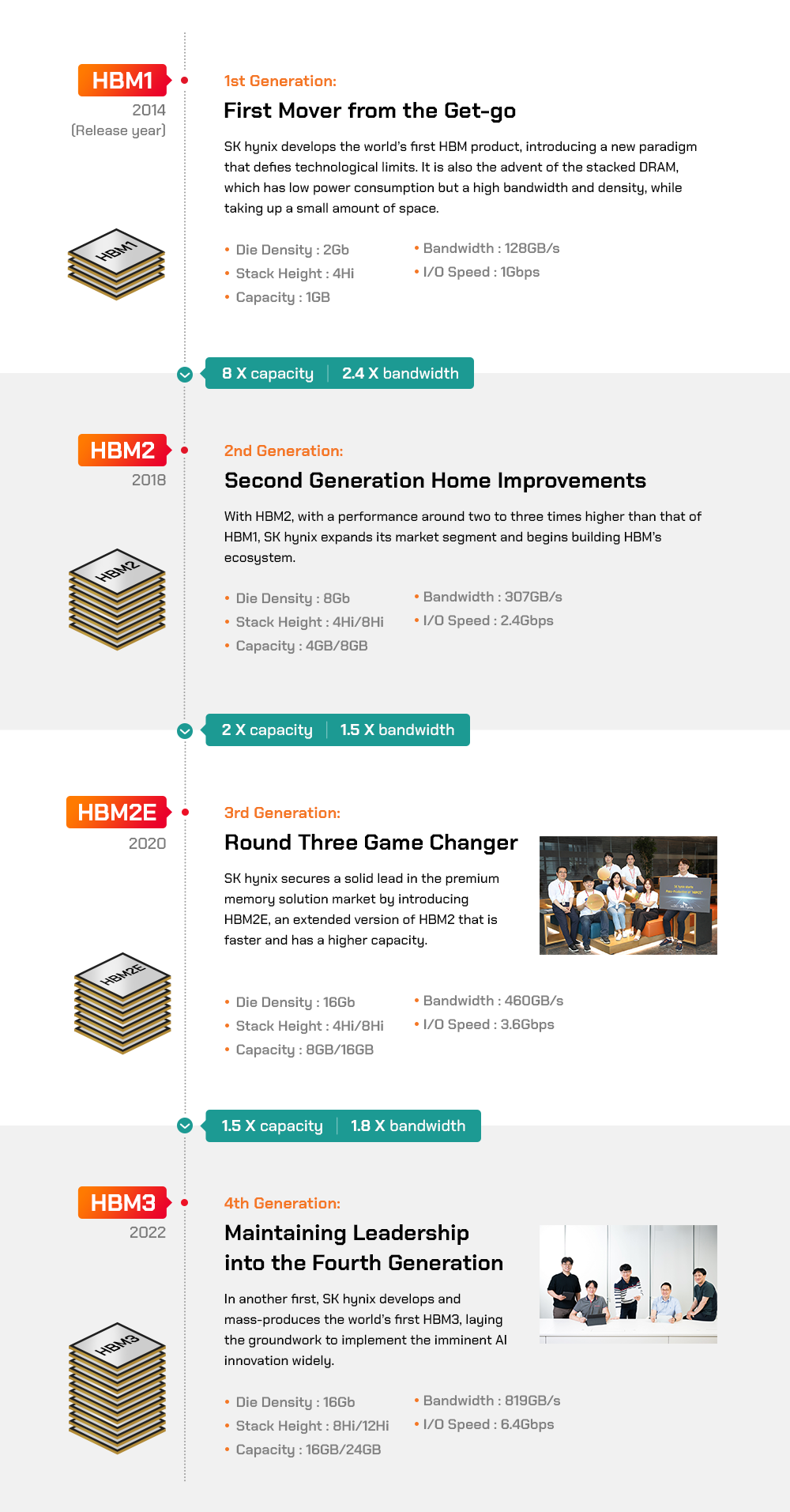When SK hynix became the first in the industry to develop HBM3, its latest HBM (High Bandwidth Memory) product, the company not only took its place in the record books but also firmly maintained its DRAM market leadership.
SK hynix announced HBM3’s development in October 2021, with the company beginning to mass produce the product in June 2022. SK hynix will also provide HBM3 for NVIDIA systems that are expected to begin shipping in the third quarter of 2022.
How did the company maintain its leadership position in this market, and what lessons did it implement from developing the previous generations of HBM products?
HBM1 – First Mover from the Get-go
When HBM was developed as a memory solution optimized for high-level computing performance (HCP), it offered a new paradigm on solving the memory bottleneck as it aimed to increase capacity and bandwidth simultaneously. SK hynix jointly developed the world’s first TSV (Through Silicon Via) HBM product with AMD in 2014. The two companies also teamed up to develop high-bandwidth 3-D stacked memory technologies and related products.
HBM1’s operating frequency is around 1,600 Mbps, the VDD (drain power voltage) is 1.2V, and the die density is 2Gb (4-hi). The product had a higher bandwidth than the DDR4 and GDDR5 products, while using less power in a substantially smaller form factor, benefitting bandwidth-hungry processors such as GPUs (graphics processing units).
HBM2 – Second Generation Home Improvements
In the second generation HBM2, released in 2018, a key improvement was the Pseudo Channel mode. This mode divides a channel into two separate 64-bit I/O sub-channels, as well as providing 128-bit prefetch per memory read and write access for each sub-channel. The mode optimizes memory accesses and lowers latency, resulting in higher effective bandwidth.
Other improvements included lane remapping modes for both hard and soft repairs of lanes, as well as anti-overheating protection. The newer technologies, alongside HBM2’s higher effective bandwidth, give it a higher energy efficiency than HBM1 at its data-rate.
HBM2E – Round Three Game Changer
SK hynix was also the first memory vendor to begin mass producing HBM2E, an extended version of HBM2. The HBM2E development team’s determination to raise the product’s specifications at the planning stage played a critical role in helping SK hynix to maintain its leadership position. The product was released two years after HBM2 in 2020, with technological updates and more applications, as well as a faster speed and higher capacity than HBM2.
The product’s 16Gb die density was double that of HBM2, achieved by vertically stacking eight 16Gb chips via TSV technology. At the time of its release, HBM2E had the industry’s fastest memory at 3.6Gbps in I/O speed and processing 460GB of data per second using 1,024 I/Os. HBM2E also has 36% better heat dissipation than HBM2.
HBM3 – Maintaining Leadership into the Fourth Generation
SK hynix continued maintaining its leadership status with HBM3, which was the world’s first of its kind when the company developed it in 2021. HBM3 has 1.5 times HBM2E’s capacity from 12 DRAM die stacked to the same total package height, enabling it to power capacity-intensive applications such as AI and HPC.
A significant addition in HBM3 compared to previous generations is a custom-designed on-die ECC (Error Correcting Code), which uses pre-allocated parity bits to check and correct errors in the data received. The code also allows DRAM to self-correct errors within cells, enhancing device reliability.
HBM3’s 16-channel architecture runs at 6.4Gbps, double that of HBM2E and currently the fastest in the world. This makes HBM3 and other HBM products an indispensable component of digital life, such as HBM products becoming a prerequisite for the Levels 4 and 5 of driving automation in autonomous vehicles.
SK hynix’s HBM development is also an important component of the company’s ESG efforts, with each generation of the product designed to consume less power than the previous one. For example, HBM3 runs at lower temperatures than HBM2E at the same level of operating voltage, enhancing the stability of the server system environment, and increasing cooling capacity.
After celebrating its HBM3 achievements, the development team has already moved onto the next step, cooperating with clients, and receiving feedback on the product. Predictions are also already out for HBM4, which could be more widely used in areas such as high-performance data centers, super computers, and artificial intelligence.
The HBM market also continues its steady growth, with the volume of data transmission increasing rapidly in the 5G era and a 2021 report by Omdia predicting that the market will generate $2.5 billion in revenue by 2025. SK hynix is looking to secure its leadership in the market by continuing to take its HBM products to the next level and maintaining its position as not only a “first mover”, but also a “solution provider”.





